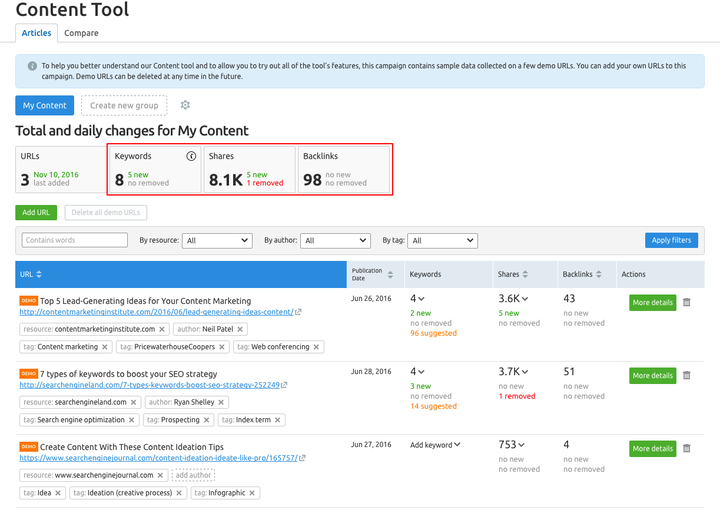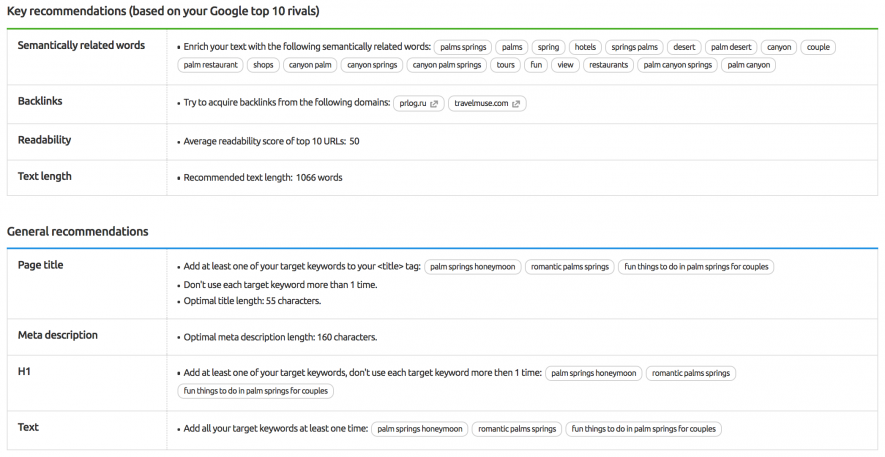Mark Healey Content Research and Creation: SEMRush Evolves with Groundbreaking Tools 37 Wow-Score The Wow-Score shows how engaging a blog post is. It is calculated based on the correlation between users’ active reading time, their scrolling speed and the article’s length. Learn more Content Research and Creation: SEMRush Evolves with Groundbreaking Tools Mark Healey
- 89
- 20
- 3
- 20
In late November 2016, SEMrush announced the launch of it’s newest open beta, Content Tool. While it doesn’t replace a content strategist’s touch, the tool does simplify tracking and success assessment and should be useful to marketers.
How to measure and understand specific metrics — like backlinks, shares, and keywords — is key to understanding a campaign’s effectiveness. This data are compiled at the top of the Content Tool.

Google’s changed the SEO game pretty drastically over the last couple years. But the most significant update is the focus on high-quality content. And with the correct tracking tools in place, SEMrush’s tools could help you understand your content’s quality and effectiveness.
The right research involves:
-
Understanding who your audience is
-
Breaking down their needs and wants
-
Defining relevant topics
-
Using data to drive the strategy
Business Goals & Content Types
Before diving into research, consider what you need your content to do, then think about the varied types you’re able to produce and manage. Resource articles, listicles, video, infographics — each serve different purposes for different audiences.
Audience Needs & Journey
How you share your content is more crucial than ever. You can’t build influence or loyalty without visibility. Take the time to map out your audiences’ journeys. What content do they need in which channels at what time? Will your brand be present when it matters?
Relevant Themes & Topics
In addition to the Content Tool, SEMrush offers the Organic Research Positions Report to display where both you and your competitors rank for specific keywords. By sifting through the percentage of traffic that certain keywords provide for a competitor, a clearer picture is painted of the content you may want to create for your audience.
For shares and overall virability, the Social Media Tool has been revamped to show absolute values and even visual updates. Not only are you able to see the social channels, but the audience, activity, and engagement per each platform.
The Backlinks Tool helps you evaluate and analyze content topics by reviewing your competitors’ backlinks. You’re able to see which pages generate the most links back to the given site.

In order to evaluate the overall effectiveness of the current content on site, there is the SEO Content Template. Key and general recommendations are given to show the changes, if any, that should be made to your current site content.
Suggestions like latent semantic indexing, rather than keyword stuffing are made prominent, alongside of the readability and length of your content.
Data-driven Strategy
It’s important to find the right tools that’ll help you analyze the effectiveness of your content. While you should have analytics for your own outlets set up, until recently third-party data was non-existent.
SEMrush’s latest helps fill that gap. Not only is your “visibility picture” more complete, but you’re armed with information that can lead to more impactful strategies. Until the next tool …



